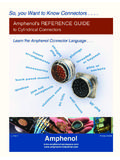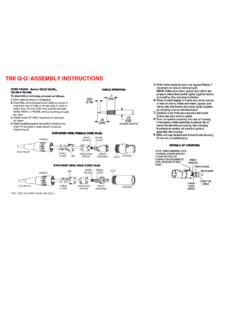Transcription of CRIMP VS. SOLDER: PROS & CONS - Davis RF
1 CRIMP VS. solder : pros & cons . Connections More Vital Than Ever Today, a flawed coaxial connection can severely reduce performance on digital systems like ThinNET (EtherNET), Wireless networks like WiFi and WLAN's and high-end video like SDTV, DTV and HDTV. Where just a few years ago a poorly installed CCTV connector might have yielded a 1dB or less loss on a CCTV. system, the same bad connection can now yield a 10dB loss on a > 1 GHz system. That could mean that only about a third of the signal would get through the connection. Let's review a few of the factors to be considered when building coaxial connections and cable assemblies.
2 First of all, whether using solder or CRIMP as your attachment method, you must bring the right tools and skills to the table. Good tools are not optional. The proper instruments and components, along with the knowledge gained from training and experience, set the stage for success in field and bench installations. Installing the connector's center contact to the cable's center conductor is more reliably achieved using either solder or CRIMP methods. Push-on, twist-on or wire-wrap methods can be very problematical and should not be considered for any assembly needed to perform over 1 GHz.
3 Both CRIMP and solder types of connection allow for solid mechanical and electrical connections. Whichever method is used, you must practice your technique. solder - This fabrication method is often considered the most labor-intensive because the connector's center contact is soldered to the cable's inner conductor. Performed properly, it is also one of the most reliable connections and can be used on cable with solid or stranded center conductors. If metals and plating of contact and cable are compatible and solder -able, and, if the technician is skilled in this type of installation, solder connections can be expected to perform for long periods of use.
4 The solder method offers several advantages for connectorization. PREFERRED. 1. solder around joint is smooth and shiny 2. No evidence of solder flow outside joint region 3. solder hole is filled flush with outside pin surface Tooling is simple: the main tool is a low-wattage solder iron with an assortment of tips and installation is aided by the use of a decent vise to hold the work in place while applying solder . Beyond that, the materials consumed are solder and flux. White Paper Connections More Vital+ Page 1 1/12/2004. PREFERRED. 1. solder around joint is smooth and shiny 2.
5 No evidence of solder flow outside joint region Soldering is much more tolerant of non-optimum technique. Disadvantages of this method: It takes more time to terminate than other methods. Cold solder joints can cause problems if the connector is not soldered properly to the cable, observing solder flow through the contact solder hole. NONCONFORMING. 1. Visible braid indicates solder fill less than 75% minimum 2. Cavity changes contour of pin 3. Electricals will be affected NONCONFORMING. 1. Excess solder flow onto body of pin 2. Excess solder changes contour of pin 3.
6 Electricals will be affected Soldered joints between contact and center conductor can work harden if subjected to excessive vibration during use and develop micro-cracks followed by solder fatigue. Soldering can be inconsistent and subject to failure as a result of mechanical or temperature stresses. Care must be taken to control heat applied during the soldering process and not allow solder to wick or distort the cable dielectric. NONCONFORMING. 1. Dielectric melted past OD + 20% maximum 2. Flare of dielectric will interfere with assembly 3. Pin has melted into dielectric 4.
7 Pin will not meet interface White Paper Connections More Vital+ Page 2 1/12/2004. PREFERRED. 4. Dielectric shows clean 90 degree stripping 5. No evidence of melting CRIMP -on - This fabrication method has always been the workhorse of the industry, and is probably the most frequently used method of terminating connectors on coax cable. The CRIMP method is the most popular because: There is no need for soldering; therefore, installation time is reduced. PREFERRED. 1. Equal compression on all 6 CRIMP surfaces 2. CRIMP die positioned within pin step down It takes an experienced technician about 15 seconds to install a CRIMP - CRIMP connector, thereby greatly reducing the time required to create cable assemblies.
8 This is very important in today's cabling market where time is of the essence and fewer technicians are being asked to maintain more and more equipment. Digital video, computer and network cabling is almost universally crimped today. Crimped connections, done correctly, can be superior to soldered connections. A good crimped connection deforms the metal sufficiently past the yield point, but not too much, so that the "spring back" keeps the connection secure, even under thermal cycling (the coefficient of expansion of the two metals might be different) and vibration.
9 A good CRIMP connection is gas tight and won't wick: it is sometimes referred to as a cold weld . Like the solder method, it can be used on solid or stranded conductors, and provides a good mechanical and electrical connection. Disadvantages of the CRIMP method are: If done poorly, the crimped contact will not seat properly within the connector taking the interface out of specification. Both signal continuity and quality will suffer. NONCONFORMING. 1. Position of CRIMP die is outside CRIMP area 2. Body of pin is no longer concentric 3. Impedance of connector will be affected White Paper Connections More Vital+ Page 3 1/12/2004.
10 NONCONFORMING. 1. Pin has been distorted, is no longer straight 2. Pin has begun to break at CRIMP Pin shows dog ear of excess material 3. Possible cause: wrong CRIMP die or too much pressure applied Crimped contacts cannot be un-crimped and re-installed. In many cases, this means the entire connector assembly must be scrapped and replaced by a new one. Crimped connections on solid wire can be poor and prone to failure, unless crimped with the proper dies using professional CRIMP handles. Sometimes, although rarely and under conditions of frequent flex, stranded wire can shift within the crimped joint and loosen.







